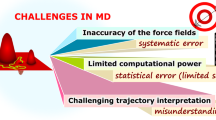Abstract
We have combined molecular dynamics simulations and fold identification procedures to investigate the structure of 696 kinked and 120 unkinked transmembrane (TM) helices in the PDBTM database. Our main aim of this study is to understand the formation of helical kinks by simulating their quasi-equilibrium heating processes, which might be relevant to the prediction of their structural features. The simulated structural features of these TM helices, including the position and the angle of helical kinks, were analyzed and compared with statistical data from PDBTM. From quasi-equilibrium heating processes of TM helices with four very different relaxation time constants, we found that these processes gave comparable predictions of the structural features of TM helices. Overall, 95 % of our best kink position predictions have an error of no more than two residues and 75 % of our best angle predictions have an error of less than 15°. Various structure assessments have been carried out to assess our predicted models of TM helices in PDBTM. Our results show that, in 696 predicted kinked helices, 70 % have a RMSD less than 2 Å, 71 % have a TM-score greater than 0.5, 69 % have a MaxSub score greater than 0.8, 60 % have a GDT-TS score greater than 85, and 58 % have a GDT-HA score greater than 70. For unkinked helices, our predicted models are also highly consistent with their crystal structure. These results provide strong supports for our assumption that kink formation of TM helices in quasi-equilibrium heating processes is relevant to predicting the structure of TM helices.








Similar content being viewed by others
References
White SH, Wimley WC (1999) Membrane protein folding and stability: physical principles. Annu Rev Biophys Biomol Struct 28:319–365
Langelaan DN, Wieczorek M, Blouin C, Rainey JK (2010) Improved helix and kink characterization in membrane proteins allows evaluation of kink sequence predictors. J Chem Inf Model 50(12):2213–2220. doi:10.1021/ci100324n
Huang YH, Chen CM (2012) Statistical analyses and computational prediction of helical kinks in membrane proteins. J Comput-Aided Mol Des 26(10):1171–1185. doi:10.1007/s10822-012-9607-5
von Heijne G (1991) Proline kinks in transmembrane α-helices. J Mol Biol 218(3):499–503. doi:10.1016/0022-2836(91)90695-3
Jacob J, Duclohier H, Cafiso DS (1999) The role of proline and glycine in determining the backbone flexibility of a channel-forming peptide. Biophys J 76(3):1367–1376. doi:10.1016/S0006-3495(99)77298-X
Chakrabartty A, Baldwin RL (1995) Stability of alpha-helices. Adv Protein Chem 46:141–176
Costantini S, Colonna G, Facchiano AM (2006) Amino acid propensities for secondary structures are influenced by the protein structural class. Biochem Biophys Res Commun 342(2):441–451. doi:10.1016/j.bbrc.2006.01.159
Gray TM, Matthews BW (1984) Intrahelical hydrogen bonding of serine, threonine and cysteine residues within α-helices and its relevance to membrane-bound proteins. J Mol Biol 175(1):75–81. doi:10.1016/0022-2836(84)90446-7
Hall SE, Roberts K, Vaidehi N (2009) Position of helical kinks in membrane protein crystal structures and the accuracy of computational prediction. J Mol Graph Model 27(8):944–950. doi:10.1016/j.jmgm.2009.02.004
Riek RP, Rigoutsos I, Novotny J, Graham RM (2001) Non-alpha-helical elements modulate polytopic membrane protein architecture. J Mol Biol 306(2):349–362. doi:10.1006/jmbi.2000.4402
Yohannan S, Faham S, Yang D, Whitelegge JP, Bowie JU (2004) The evolution of transmembrane helix kinks and the structural diversity of G protein-coupled receptors. Proc Natl Acad Sci USA 101(4):959–963. doi:10.1073/pnas.0306077101
Cao Z, Bowie JU (2012) Shifting hydrogen bonds may produce flexible transmembrane helices. Proc Natl Acad Sci USA 109(21):8121–8126. doi:10.1073/pnas.1201298109
Meruelo AD, Samish I, Bowie JU (2011) TMKink: a method to predict transmembrane helix kinks. Protein Sci 20(7):1256–1264. doi:10.1002/pro.653
Kneissl B, Mueller SC, Tautermann CS, Hildebrandt A (2011) String kernels and high-quality data set for improved prediction of kinked helices in alpha-helical membrane proteins. J Chem Inf Model 51(11):3017–3025. doi:10.1021/ci200278w
Popot JL, Engelman DM (1990) Membrane protein folding and oligomerization: the two-stage model. Biochemistry 29(17):4031–4037
Chen CC, Chen CM (2009) A dual-scale approach toward structure prediction of retinal proteins. J Struct Biol 165(1):37–46. doi:10.1016/j.jsb.2008.10.001
Chen CC, Wei CC, Sun YC, Chen CM (2008) Packing of transmembrane helices in bacteriorhodopsin folding: structure and thermodynamics. J Struct Biol 162(2):237–247. doi:10.1016/j.jsb.2008.01.003
Wu HH, Chen CC, Chen CM (2012) Replica exchange Monte-Carlo simulations of helix bundle membrane proteins: rotational parameters of helices. J Comput Aided Mol Des 26(3):363–374. doi:10.1007/s10822-012-9562-1
Werner T, Church WB (2013) Kink characterization and modeling in transmembrane protein structures. J Chem Inf Model 53(11):2926–2936. doi:10.1021/ci400236s
Wang G, Dunbrack RL Jr (2003) PISCES: a protein sequence culling server. Bioinformatics 19(12):1589–1591
Case DA, Cheatham TE III, Darden T, Gohlke H, Luo R, Merz KM Jr, Onufriev A, Simmerling C, Wang B, Woods RJ (2005) The Amber biomolecular simulation programs. J Comput Chem 26(16):1668–1688. doi:10.1002/jcc.20290
Zhang Y, Skolnick J (2004) SPICKER: a clustering approach to identify near-native protein folds. J Comput Chem 25(6):865–871. doi:10.1002/jcc.20011
Tsong TY (1990) Electrical modulation of membrane proteins: enforced conformational oscillations and biological energy and signal transductions. Annu Rev Biophys Biophys Chem 19:83–106. doi:10.1146/annurev.bb.19.060190.000503
Chen CM (2001) Lattice model of transmembrane polypeptide folding. Phys Rev E 63(1):010901. doi:10.1103/PhysRevE.63.010901
Chen CM, Chen CC (2003) Computer simulations of membrane protein folding: structure and dynamics. Biophys J 84(3):1902–1908
Hunenberger P (2005) Thermostat algorithms for molecular dynamics simulations. Adv Polym Sci 173:105–147. doi:10.1007/B99427
Read RJ, Chavali G (2007) Assessment of CASP7 predictions in the high accuracy template-based modeling category. Proteins 69(Suppl 8):27–37. doi:10.1002/prot.21662
Acknowledgments
This work is supported by the National Science Council of Taiwan under grant of no. NSC 99-2112-M-003 -011 -MY3. We thank D.N. Langelaan for providing the MC-HELAN algorithm, and Y.-H. Huang for stimulating discussion.
Author information
Authors and Affiliations
Corresponding author
Electronic supplementary material
Below is the link to the electronic supplementary material.
Rights and permissions
About this article
Cite this article
Mai, TL., Chen, CM. Computational prediction of kink properties of helices in membrane proteins. J Comput Aided Mol Des 28, 99–109 (2014). https://doi.org/10.1007/s10822-014-9734-2
Received:
Accepted:
Published:
Issue Date:
DOI: https://doi.org/10.1007/s10822-014-9734-2




